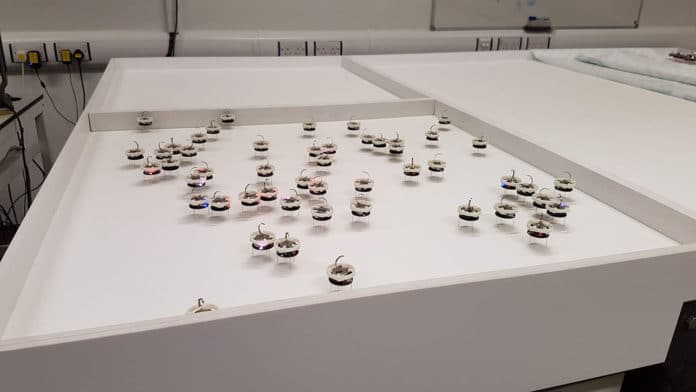In order to effectively perform collective monitoring of dynamic environments, a robot swarm needs to adapt to changes by processing the latest information and discarding outdated beliefs.
Engineers at the University of Sheffield have discovered how to make swarms of robots work together more effectively. The new research found that swarms of multiple robots can fight wildfires, conduct search and rescue operations at sea, and diagnose problems inside the human body most effectively when communication between the robots is kept to a minimum.
The team discovered that the robots work together and adapt to changes in their surroundings more efficiently when programmed to communicate only with other robots within 10cm of each other rather than the whole swarm.
The research disproves the widely accepted theory that greater numbers of communications between robots lead to a more effective exchange of information.
Engineers studied how a swarm of tiny robots moved around and reached a consensus on the best area they should gather in and explore. The team observed a swarm of robots when each robot was able to access the environment individually, make its own decision on the best area and broadcast its opinion to the rest of the swarm. Each robot in the swarm then periodically selected a random assessment that had been broadcast by another robot in the swarm and used it to update its opinion on the best area – a protocol called the voting model in robotics.
The protocol allowed the swarms to reach a consensus on the best area to gather and explore based on the opinions of each robot. However, using this protocol, the robot swarm was slow to adapt to changes in the environment.
When robots were instructed to broadcast their “opinion” to others within a 10cm range, the swarm was able to adapt to changes in their environment much quicker and select the best available area, the researchers found.
“Swarms of robots have huge potential to help us access places that are either too hazardous or simply inaccessible to humans,” said Dr. Andreagiovanni Reina from the University of Sheffield’s department of computer science. “For example, they could fly over a forest fire that is too vast or dangerous for humans to tackle alone, monitor how the fire spreads, and decide where help is needed the most.
“However, what happens if the fire suddenly changes direction and support is urgently needed elsewhere – the swarm of robots needs to be able to quickly adapt to this change and identify where the urgent support is needed. This is what our research is helping to do – our findings could be used to develop swarms of robots that are more responsive and able to make the right decisions much quicker than they currently can do.“
Hardy enough to withstand tough environments, miniature robots could prove extremely useful for locating missing humans and aiding in relief efforts during disasters.
